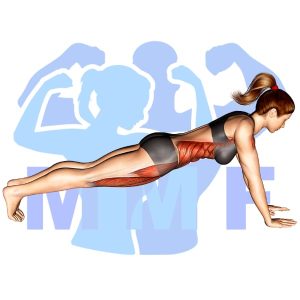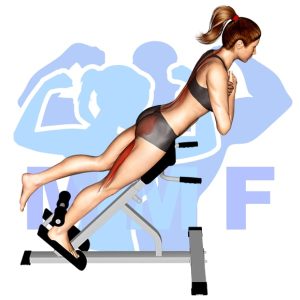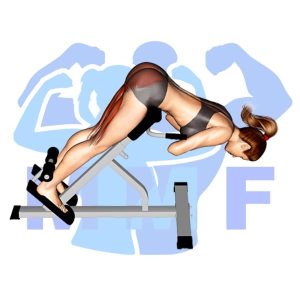Have you ever struggled with lower-back pain or discomfort in your hip flexors? Well, you’re not alone. The sedentary lifestyle and extended periods of sitting have made hip problems a common occurrence. Tight hip flexors can cause various issues like back pain, poor posture, and even trouble sleeping. The good news is that there’s a simple exercise that can help: the hip lift. In this post, we will go over why hip lifts are beneficial and how you can incorporate them into your fitness routine for a pain-free lifestyle.
Hip Lift Summary
- Primary Muscles: Rectus Abdominis
- Secondary Muscles: Quadriceps
- Equipment: Body Weight
- Mechanics Type: Isolated
- Force: Push
- Utility: Auxiliary

Hip Lift Instructions
- Get started by lying flat on your back with your hands at your side.
- Now lift your legs up straight so they are directly above your hips. This is the starting position.
- Next, lift your hips off the ground and your legs straight up in the air.
- Then lower your hips back to the ground, keeping your legs pointed up.
- You have completed one rep, continue for a full set or go until failure.
Video Tutorial
Hip Lift Muscles
Target (Agonist)
Synergists
Dynamic Stabilizers
- None
Stabilizers
- Hip Adductors (opposite)
Antagonist Stabilizers

Benefits of Hip Lift
The hip lift is a great exercise to include in any strength training or fitness routine. It targets the Rectus Abdominis, a muscle located in the abdomen that helps to support the spine, maintain posture, and aid in trunk rotation. Strengthening this muscle can help to improve core stability and balance. Additionally, the hip lift works to strengthen the hip flexors and hamstrings, which can improve flexibility and reduce the risk of injury. It also helps to engage the glutes, which helps to reduce lower back pain and improve overall posture. By incorporating the hip lift into your routine, you can improve your core strength and stability while reducing the risk of injury and improving flexibility.
Tips for Performing Hip Lift
If you’re seeking to take your hip lift to the next level, then you’re at the right place. Using these suggestions can allow you to take full advantage of this amazing exercise. You will shape your abs muscles, and even lower your risk of experiencing an injury. So let’s begin right now and see what these tips may achieve for you.
- Engage your core: Make sure to activate your core muscles to ensure you are getting the most out of each hip lift. Doing so will help to increase your stability and balance as you move through the exercise, giving you a greater overall benefit.
- Keep your breathing steady: As you move through the hip lift, focus on keeping your breathing steady and rhythmic. This will help you to maintain control of the movement and make it easier to complete the full range of motion.
- Don’t forget to stretch: Stretching is an important part of any exercise routine, and hip lifts are no exception. Taking a few moments after each set of hip lifts to stretch your hips and lower back will help reduce the risk of injury and improve your flexibility.
Benefits and Tips Video
Frequent Mistakes To Avoid
Avoiding common mistakes might mean the difference between a productive training session and an injury when executing hip lift. Also, in order to maximize your benefits of the exercise, proper form is required. By preventing these common mistakes, you may improve your ability to achieve your desired results. But relax, it’s not quite as difficult as it might seem. By knowing the errors to avoid and taking the right actions, you can execute the exercise securely and effectively. Let’s start by avoiding these typical mistakes and incorporating this exercise to your training regimen.
- Not engaging their core muscles: Many women neglect to engage their core muscles when performing a hip lift, which can lead to poor form and an ineffective workout.
- Doing the exercise too quickly: Doing the hip lift exercise too quickly can reduce the effectiveness of the workout and increase the risk of injury.
- Not using proper breathing techniques: Improper breathing techniques can limit the effectiveness of the hip lift exercise, and cause fatigue more quickly. It is important to ensure proper breathing techniques are used to maximize results.
Find More Bodyweight Exercises Here
Variations and Complementary Exercises
An effective exercise to strengthen the muscles around your hips is the Hip Lift. But if you’re looking for variations, complementary, or alternative exercises that work similar muscles, here are a few to try:
Bridge On Knees

Bridge on Knees is a complementary exercise to the Hip Lift, as it provides an opportunity for the hip flexors to be activated and strengthened. Bridge on Knees is a great alternative exercise for the Hip Lift, as it is much gentler on the back and doesn’t require any equipment. To perform the exercise, you start by lying flat on your back and bring your knees towards your chest. Then you slowly lift your hips off the ground, while keeping your shoulders and head on the ground. You can then hold the position for a few seconds and then slowly lower yourself back down. This exercise strengthens your core and glutes, while also activating your hip flexors.
Bridge

Bridge is a great complementary exercise for the hip lift. It can help to strengthen the lower back and abdominal muscles, which are essential for performing hip lifts correctly. This exercise also helps to improve balance and stability in the lower body. Bridge works to support the hip lift by engaging the glutes, hamstrings, and core muscles, all of which work together to stabilize the body during the exercise. Additionally, bridge can help to stretch out the hip flexors which may be tight due to doing hip lifts. By incorporating bridge into your routine, you can increase your range of motion and strength while also providing an effective alternative exercise.
Bench Crunch

Bench Crunch is a great exercise to add to your routine if you’re looking for an alternative or complementary exercise to Hip Lift. It targets the abdominal muscles, providing a great core workout. To do a Bench Crunch, you’ll need a flat bench and a weight. Lie on your back on the bench, holding the weight above your chest. Engage your core and curl your torso up towards your knees, then slowly lower your body back to the bench. This exercise strengthens the abs and helps to improve balance and stability.
Check Out These Top Bodyweight Exercises
V Up

V Up is a great complementary or alternative exercise to the Hip Lift. It targets both the lower and upper abdominals as well as the hip flexors. It works the same muscles as the Hip Lift but in a different way. The V Up requires the person to lift their legs and torso simultaneously while keeping the arms and legs extended. This motion engages the core while at the same time stretching the hip flexors. It is a great exercise to improve core strength and stability, and it can help to increase flexibility and range of motion in the hips as well.
Straight Arm Crunch

The Straight Arm Crunch is a great alternative or complementary exercise for the Hip Lift. It targets the abdominal muscles and strengthens the core, helping to improve stability and posture. The exercise involves lying on your back with your legs bent and feet flat on the floor, arms extended straight behind your head, and head and neck in a neutral position. Then, slowly curl your upper body up towards the ceiling until your shoulder blades come off the floor, hold for a moment, and then slowly lower back down. This exercise helps to build strength and definition in the abdominal muscles and can help to improve the overall effectiveness of the Hip Lift.
Straight Arm Bridge

The Straight Arm Bridge is a great complementary or alternative exercise to the Hip Lift. It helps to strengthen the glutes, hamstrings, and core muscles while also stretching the hip flexors. It is an isometric exercise that involves pushing your hips up while keeping your legs and arms straight. The bridge pose helps to improve posture and balance while also providing relief from lower back pain. It is a great addition to any workout routine as it helps to increase core strength and stability.
Find More Abs Exercises Here
Opposing Complementary Exercises
In order to maximize the benefits of the Hip Lift, it is recommended to include exercises that work the opposite muscles in your workout. To help you achieve this, below is a list of exercises that complement the Hip Lift by using opposing muscle groups.
45 Degree Twisting Hyperextension

The 45 Degree Twisting Hyperextension is a great exercise to complement the Hip Lift as it works the opposing muscle group. This exercise targets the posterior chain muscles, such as the glutes, hamstrings and lower back. It is performed by lying face down on a 45 degree hyperextension bench with your feet secured. From this position, you will lift your torso up while twisting to one side, then back to the starting position before repeating on the other side. This exercise is beneficial in strengthening the muscles of the lower back, which are often neglected during traditional hip lift exercises. By strengthening these muscles, it helps to create balance in the body and can help to prevent injury.
45 Degree One Leg Hyperextension

The 45 Degree One Leg Hyperextension is a great complement to the Hip Lift exercise. This exercise works the lower back and gluteal muscles by having the exerciser lie face down on a bench, with one foot on the ground, and the other leg lifted off the ground and bent at a 45 degree angle. The exerciser then lifts their hips off the bench as far as possible before slowly lowering them back down. This exercise works the opposing muscle group to the Hip Lift, activating and strengthening the hamstrings, glutes, and lower back muscles. By doing both exercises in combination, you will not only be able to strengthen both muscle groups but also improve your balance and stability.
45 Degree Hyperextension

The 45 Degree Hyperextension is a great exercise to complement the Hip Lift. It works the opposing muscle group, engaging the lower back and glutes, while stretching the hamstrings. It is a great way to work the entire posterior chain and increase overall strength and mobility. This exercise can be done with weights to increase the intensity or without weights for a more moderate workout. The 45 Degree Hyperextension helps to balance out the strength and flexibility in the lower body, which can help to prevent injury and improve performance.
Elevate Your Fitness With The Hip Lift!
If you’re looking to elevate your fitness, look no further than the hip lift! This dynamic exercise can engage multiple muscle groups, including your glutes, lower back, and core. By working on these areas, you can improve your overall strength and stability, leading to better posture and fewer injuries. Plus, incorporating hip lift exercises into your routine can help boost your metabolism and burn more calories. So why not give it a try and see how it can take your fitness journey to the next level?
References: Wikipedia | ExRx.net | PubMed.gov | Comprehensive List of Abs Bodyweight Exercises

